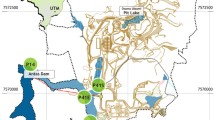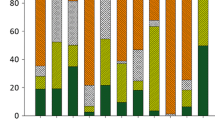Abstract
The United States Environmental Protection Agency has defined national in-stream water-quality criteria (WQC) for 157 pollutants. No WQC to protect aquatic life exist for total dissolved solids (TDS). Some water-treatment processes (e.g., pH modifications) discharge wastewaters of potentially adverse TDS into freshwater systems. Strong correlations between specific conductivity, a TDS surrogate, and several biotic indices in a previous study suggested that TDS caused by a coal-mine effluent was the primary stressor. Further acute and chronic testing in the current study with Ceriodaphnia dubia in laboratory-manipulated media indicated that the majority of the effluent toxicity could be attributed to the most abundant ions in the discharge, sodium (1952 mg/L) and/or sulfate (3672 mg/L), although the hardness of the effluent (792 ± 43 mg/L as CaCO3) ameliorated some toxicity. Based on laboratory testing of several effluent-mimicking media, sodium- and sulfate-dominated TDS was acutely toxic at approximately 7000 μS/cm (5143 mg TDS/L), and chronic toxicity occurred at approximately 3200 μS/cm (2331 mg TDS/L). At a lower hardness (88 mg/L as CaCO3), acute and chronic toxicity end-points were decreased to approximately 5000 μS/cm (3663 mg TDS/L) and approximately 2000 μS/cm (1443 mg TDS/L), respectively. Point-source discharges causing in-stream TDS concentrations to exceed these levels may risk impairment to aquatic life.


Similar content being viewed by others
References
American Public Health Association, American Water Works Association & Water Environment Federation (1995) Standard methods for the examination of water and waste water, 19th ed. American Public Health Association, Washington, DC
BL Burnham JJ Peterka (1975) ArticleTitleEffects of saline water from North Dakota lakes on survival of Fathead Minnow (Pimephales promelas) embryos and sac fry J Fish Res Board Can 32 809– 812
PM Chapman H Bailey E Canaria (2000) ArticleTitleToxicity of total dissolved solids associated with two mine effluents to Chironomid larvae and early life stages of rainbow trout Environ Toxicol Chem 19 210–214 Occurrence Handle10.1897/1551-5028(2000)019<0210:TOTDSA>2.3.CO;2
UM Cowgill DP Milazzo (1991) ArticleTitleThe sensitivity of two cladocerans to water quality variables: Salinity <467 mg NaCl/L and hardness <200 mg CaCO3/L Arch Environ Contam Toxicol 21 218–223 Occurrence Handle10.1007/BF01055340
Currie RJ (1999) Identification of ecosystem stressors in developing an enhancement plan for the Leading Creek Watershed, Meigs County, Ohio. Virginia Polytechnic Institute and State University, doctoral dissertation
GM DeGraeve JD Cooney BH Marsh TL Pollock NG Reichenbach (1992) ArticleTitleVariability in the performance of the 7-d Ceriodaphnia dubia survival and reproduction test: an intra- and interlaboratory comparison Environ Toxicol Chem 11 851–866
KK Dickerson WA Hubert HL Berman (1996) ArticleTitleToxicity assessment of water from lakes and wetlands receiving irrigation drain water Environ Toxicol Chem 15 1097–1101 Occurrence Handle10.1897/1551-5028(1996)015<1097:TAOWFL>2.3.CO;2
PA Goetsch CG Palmer (1997) ArticleTitleSalinity tolerances of selected macroinvertebrates of the Sabie River, Kruger National Park, South Africa Arch. Environ Contam Toxicol 32 32–41 Occurrence Handle10.1007/s002449900152 Occurrence Handle9002432
WL Goodfellow LL Ausley DT Burton DL Denton PB Dorn DR, Grothe et al. (2000) ArticleTitleMajor ion toxicity in effluents: a review with permitting recommendations Environ Toxicol Chem 19 175–182 Occurrence Handle10.1897/1551-5028(2000)019<0175:MITIEA>2.3.CO;2
JM Grizzle II AC Mauldin D Young E Henderson (1990) ArticleTitleEffects of environmental calcium and sodium on postharvest survival of juvenile striped bass J Aquat Anim Health 2 104–108 Occurrence Handle10.1577/1548-8667(1990)002<0104:EOECAS>2.3.CO;2
Gulley DD (1996) Toxstat, version 3.3. University of Wyoming Department of Zoology and Physiology, Laramie, WY
BT Hart P Bailey R Edwards K Hortle K James A, McMahon et al. (1991) ArticleTitleA review of the salt sensitivity of the Australian freshwater biota Hydrobiologia 210 105–144
CG Ingersoll FJ Dwyer SA Burch MK Nelson DR Buckler JB Hunn (1992) ArticleTitleThe use of freshwater and saltwater animals to distinguish between the toxic effects of salinity and contaminants in irrigation drain water Environ Toxicol Chem 11 503–511
BP Jackson PJ Lasier WP Miller PW Winger (2000) ArticleTitleEffects of calcium, magnesium, and sodium on alleviating cadmium toxicity to Hyalella azteca Bull Environ Contam Toxicol 64 279–286 Occurrence Handle10.1007/s001289910041 Occurrence Handle10656896
AJ Kennedy DS Cherry RJ Currie (2003) ArticleTitleField and laboratory assessment of a coal-processing effluent in the Leading Creek Watershed, Meigs Co., Ohio Arch Environ Contam Toxicol 44 324–331 Occurrence Handle10.1007/s00244-002-2062-x Occurrence Handle12712291
Kleinmann RLP, Watzlaf GR (1988) Should the effluent limits for manganese be modified? Paper presented at the Mine Drainage Reclamation Conference sponsored by the American Society for Surface Mining and Reclamation and the U.S. Department of Interior, April 17-22, 1988, Pittsburgh, PA
TM Koel JJ Peterka (1995) ArticleTitleSurvival to hatching of fishes in sulfate-saline waters, Devils Lake, North Dakota Can J Fish Aquat Sci 52 464–469
Latimer HA (1999) An ecotoxicological evaluation of active coal mining, sedimentation and acid mine drainage in three tributaries of the Leading Creek Watershed, Meigs County, Ohio. Masters thesis, Virginia Polytechnic Institute and State University, Blacksburg, VA
GA Leblanc DC Surprenant (1984) ArticleTitleThe influence of mineral salts on fecundity of the water flea (Daphnia magna) and the implications on toxicity testing of industrial wastewater Hydrobiologia 108 25–31
RG Masnado SW Geis WC Sonzogogni (1995) ArticleTitleComparative acute toxicity of a synthetic mine effluent to Ceriodaphnia dubia, larval Fathead Minnow and the Freshwater mussel Anodonta imbecilis Environ Toxicol Chem 14 1913–1920
McCauley DJ, Brook LT, Call DJ, Lindberg CA (1986) Acute and chronic toxicity of aluminum to Ceriodaphnia dubia at various pHs. Center for Lake Superior Environmental Studies, University of Wisconsin-Superior, WI, doctoral dissertation
PG McWilliams (1983) ArticleTitleAn investigation of the loss of bound calcium from the gills of the brown trout, Salmo trutta, in acid media Comp Biochem Physiol 74A 107–116 Occurrence Handle10.1016/0300-9629(83)90720-X
PG McWilliams WTW Potts (1978) ArticleTitleThe effects of pH and calcium concentrations on gill potentials in the brown trout, Salmo trutta J Comp Physiol 126B 277–286
JS Meyer DA Sanchez JA Brookman DB McWhorter HL Bergman (1985) ArticleTitleChemistry and aquatic toxicity of raw oil shale leachates from Piceance Basin, Colorado Environ Toxicol Chem 4 559–572
DR Mount DD Gulley JR Hockett TD Garrison JM Evans (1997) ArticleTitleStatistical models to predict the toxicity of major ions to Ceriodaphnia dubia, Daphnia magna and Pimephales promelas (Fathead Minnows) Environ Toxicol Chem 16 2009–2019 Occurrence Handle10.1897/1551-5028(1997)016<2009:SMTPTT>2.3.CO;2
P Pic J Maetz (1981) ArticleTitleRole of external calcium in sodium and chloride transport in the gills of seawater-adapted Mugil capito J Comp Physiol 141 511–521
J Sall A Lehman (1996) JMP start statistics SAS Institute. Duxbury Press Belmont, CA
Soucek DJ, Kennedy AJ. Effects of hardness, chloride, and acclimation on the acute toxicity of sulfate to freshwater invertebrates. Environ Toxicol Chem (in press)
JE Tietge DR Mount DD Gulley (Eds) (1994) Freshwater model and computer program: overview, validation, and application Gas Research Institute Chicago, IL (sponsoring organization); ENSR Consulting Engineering, Fort Collins, Co (performing organization)
United States Environmental Protection Agency (1993) Methods for measuring the acute toxicity of effluents and receiving waters to freshwater and marine organisms, 4th ed. Washington D.C. EPA/600/4-90/027F, Cincinnati, OH
United States Environmental Protection Agency (1994) Short-term methods for estimating the chronic toxicity of effluents and receiving water to freshwater organisms, 3rd ed. Washington D.C. EPA-600-4-91-002, Cincinnati, OH
United States Environmental Protection Agency (1999) National Recommended water quality criteria-correction. EPA-822-Z-99-001. Office of Water, Washington, DC
PG Welch J Lipton GA Chapman TL Podrabsky (2000) ArticleTitleRelative importance of calcium and magnesium in hardness-based modification of copper toxicity Environ Toxicol Chem 19 1624– 1631 Occurrence Handle10.1897/1551-5028(2000)019<1624:RIOCAM>2.3.CO;2
Zipper CE (2000) Coal mine reclamation, acid mine drainage, and the Clean Water Act. In: Barnhisel R, Daniels W, Darmody R (eds) Reclamation of drastically disturbed lands. American Society of Agronomy, Madison, WI, Monograph 41, 169–191
Acknowledgments
The authors thank Dr. Rebecca Currie, Matthew Hull, T. Chad Merricks, Patrick Barry, and Brian Denson for suggestions and assistance in the laboratory and field. We also thank Drs. David Soucek, E.F. Benfield, and Roderic Millward as well as two anonymous reviewers for thoughtful suggestions regarding the manuscript.
Author information
Authors and Affiliations
Corresponding author
Rights and permissions
About this article
Cite this article
Kennedy, A.J., Cherry, D.S. & Zipper, C.E. Evaluation of Ionic Contribution to the Toxicity of a Coal-Mine Effluent Using Ceriodaphnia dubia. Arch Environ Contam Toxicol 49, 155–162 (2005). https://doi.org/10.1007/s00244-004-0034-z
Received:
Accepted:
Published:
Issue Date:
DOI: https://doi.org/10.1007/s00244-004-0034-z




